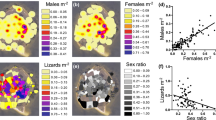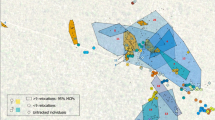Summary
Patterns of disappearance and dispersal of Spermophilus elegans juveniles during the first 6-weeks postemergence were compared for 1977 and 1978 and related to quantitative and qualitative changes in social interaction involving juveniles.
Juvenile disappearance (emigration or mortality) and dispersal within the study site varied between the sexes within and between years. Female disappearance and dispersal were significantly greater in 1977, and male losses in 1978 significantly exceeded male losses in 1977. Greater female loss in 1977 resulted in total male — female losses being equivalent, whereas in 1978 juvenile loss was strongly biased toward males by the end of the 6-week period.
Greater female loss in 1977 was attributed primarily to increased aggression between female juveniles in that year because of larger average litter size with more females per litter. Increased disappearance of males in 1978 showed no correlation with litter size or relative increase in number of males per litter. Male young interacted with individuals of several age/sex classes, and a possible behavioral influence on male disappearance was increased aggressiveness by yearling males toward juvenile males in 1978.
Behavior appeared to act as a proximate factor in juvenile disappearance and dispersal, and the observed differences between how male and female juveniles interacted in 1977 and 1978 were hypothesized to reflect the operation of different selective pressures to increase individual male or female fitness.
Similar content being viewed by others
References
Altmann J (1974) Observational study of behaviour sampling methods. Behaviour 49:227–267
Armitage KB (1973) Population changes and social behavior following colonization by the yellow-bellied marmot. J Mammal 54:842–854
Armitage KB (1974) Male behaviour and territoriality in the yellow-bellied marmot. J Zool 172:233–265
Armitage KB, Downhower JF (1974) Demography of yellow-bellied marmot populations. Ecology 55:1233–1245
Carl EA (1971) Population control in Arctic ground squirrels. Ecology 52:395–413
Chitty D (1960) Population processes in the vole and their relevance to general theory. Can J Zool 38:99–113
Chitty D (1967) The natural selection of self-regulatory behaviour in animal populations. Proc Ecol Soc Aust 2:51–78
Christian JJ (1950) The adreno-pituitary system and population cycles in mammals. J Mammal 31:247–259
Dobson FS (1979) An experimental study of dispersal in the California ground squirrel. Ecology 60:1103–1109
Dorrance MJ (1974) The annual cycle and population dynamics of Richardson's ground squirrels. PhD thesis, University of Wisconsin, Madison, Wisconsin
Dunford C (1977) Social system of round-tailed ground squirrels. Anim Behav 25:885–906
Fairbairn DJ (1978) Dispersal of deer mice, Peromyscus maniculatus. Oecologica (Berl) 32:171–194
Fritts SH, Mech LD (1981) Dynamics, movements, and feeding ecology of a newly protected wolf population in northwestern Minnesota. Wildl Monogr 80:1–79
Greenwood PJ (1980) Mating systems, philopatry and dispersal in birds and mammals. Anim Behav 28:1140–1162
McCarley H (1966) Annual cycle, population dynamics and adaptive behavior of Citellus tridecemlineatus. J Mammal 47:294–316
Michener GR (1979) Spatial relationships and social organization of adult Richardson's ground squirrels. Can J Zool 57:125–139
Michener GR (1980) The measurement and interpretation of interaction rates: an example with adult Richardson's ground squirrels. Biol Behav 5:371–384
Myers JH, Krebs CJ (1971) Genetic, behavioral, and reproductive attributes of dispersing field voles Microtus pennsylvanicus and M. ochrogaster. Ecol Monogr 41:53–77
Pfeifer SR (1980a) Demographic and behavioral influences on dispersal of juvenile Wyoming ground squirrels. PhD thesis, University of Colorado, Boulder, Colorado
Pfeifer SR (1980b) Aerial predation on Wyoming ground squirrels. J Mammal 61:371–372
Pfeifer SR (1982) Variability in reproductive output and success of Spermophilus elegans ground squirrels. J Mammal 63
Rusch DA, Reeder WG (1978) Population ecology of Alberta red squirrels. Ecology 59:400–420
Sadleir R (1965) The relationship between agonistic behaviour and population changes in the deer mouse, Peromyscus maniculatus Wagner. J Anim Ecol 34:331–352
Schmutz SM, Boag DA, Schmutz JK (1979) Causes of the unequal sex ratio in poulations of adult Richardson's Ground Squirrels. Can J Zool 57:1849–1855
Slade NA, Balph DF (1974) Population ecology of Uinta ground squirrels. Ecology 55:989–1003
Storm GE (1972) Population dynamics of red foxes in north central United States. PhD thesis, University of Minnesota, Minneapolis, Minnesota
Svendsen GE (1974) Behavioral and environmental factors in the spatial distribution and population dynamics of a yellow-bellied marmot population. Ecology 55:760–771
Svendsen GE, Armitage KB (1973) Mirror-image stimulation applied to field behavioral studies. Ecology 54:623–627
Turner LW (1972) Autecology of the Belding ground squirrel in Oregon. PhD thesis, University of Arizona, Tucson, Arizona
Watson A, Moss R (1970) Dominance, spacing behaviour and aggression in relation to population limitation in vertebrates. In: Watson A (ed) Animal populations in relation to their food resources. Blackwell, Oxford pp 167–218
Yeaton RI (1972) Social behavior and social organization in Richardson's ground squirrel (Spermophilus richardsonii richardsonii) in Saskatchewan. J Mammal 53:139–147
Zegers DA, Williams O (1977) Seasonal cycles of body weight and lipids in Richardson's ground squirrel, Spermophilus richardsonii elegans. Acta Theriol 22:380–383
Author information
Authors and Affiliations
Rights and permissions
About this article
Cite this article
Pfeifer, S. Disappearance and dispersal of Spermophilus elegans juveniles in relation to behavior. Behav Ecol Sociobiol 10, 237–243 (1982). https://doi.org/10.1007/BF00302812
Received:
Accepted:
Issue Date:
DOI: https://doi.org/10.1007/BF00302812




